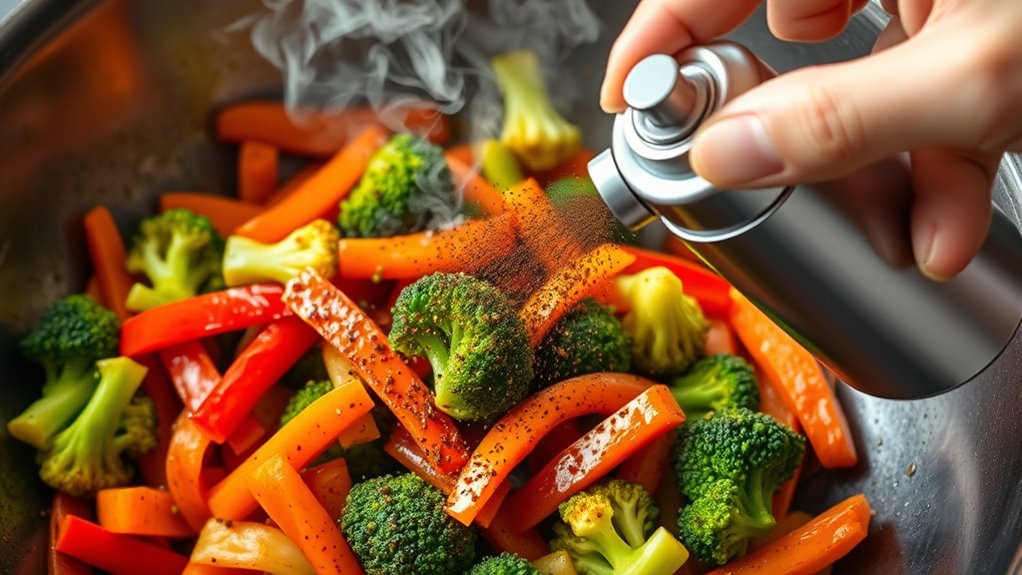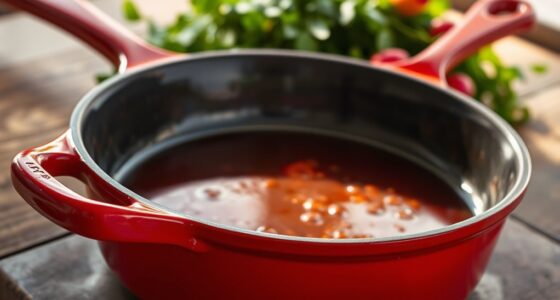The biggest mistake ruining your stir fry is skipping the initial burn-in process when seasoning your wok. Without this essential step, you haven’t built a strong, non-stick surface that enhances flavors and prevents rust. Many rush this stage or apply too much oil, leading to sticky spots or dull seasoning. If you keep avoiding proper seasoning techniques, your wok’s performance will suffer over time. Keep going, and you’ll discover how to properly build and care for your wok for perfect results.
Key Takeaways
- Using soap or harsh cleaners strips away the seasoning layer, reducing non-stick properties and causing rust.
- Applying too much oil during seasoning creates a sticky surface that attracts debris and hampers proper non-stick development.
- Skipping the initial burn-in process prevents the formation of a durable, smooth seasoning layer, leading to uneven cooking.
- Not preheating the wok properly before oil application results in poor seasoning adhesion and reduced non-stick effectiveness.
- Neglecting regular re-seasoning and maintenance causes seasoning deterioration, leading to sticky spots and compromised stir-fry performance.
Skipping the Initial Burn-In Process
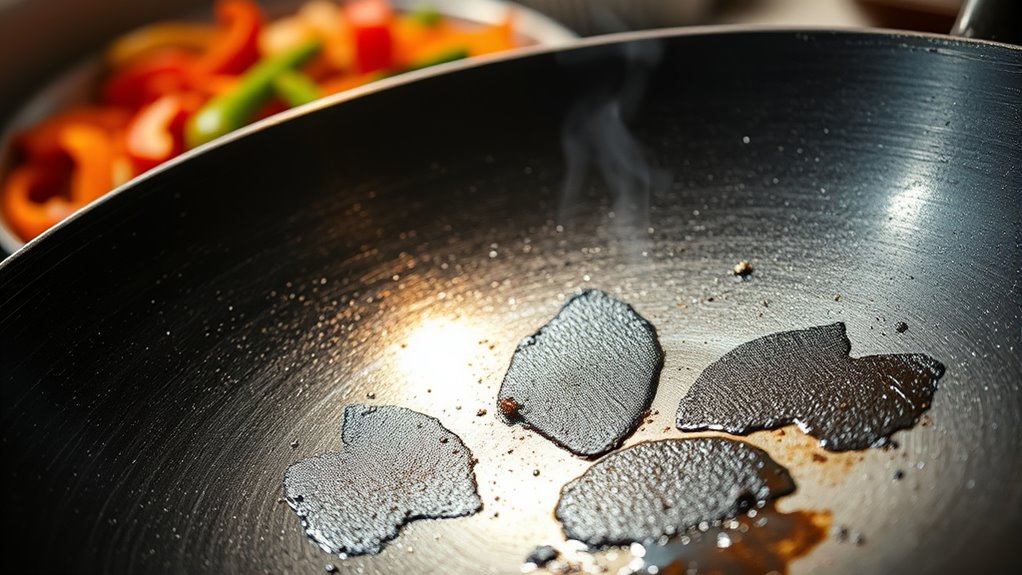
Many beginners skip the initial burn-in process, but doing so can lead to seasoning issues and uneven heat distribution. When you skip this step, your wok doesn’t develop a proper non-stick surface, making it harder to cook food evenly. The burn-in process helps polymerize the oil, creating a durable coating that protects the wok and enhances flavor. Without it, food may stick, and your wok can develop rust or uneven spots. It’s tempting to skip because it seems time-consuming, but ignoring this step compromises your wok’s performance. To avoid this mistake, you need to heat your wok thoroughly and apply a thin layer of oil, then heat it again. This process builds up a smooth, seasoned surface that improves with each use. Proper seasoning also enhances the wok’s longevity, ensuring it remains functional and safe over time. Additionally, understanding the chemical reactions involved in seasoning can help you achieve a more durable and effective coating. Regularly maintaining your wok’s surface by reseasoning when necessary will help preserve the non-stick properties and prevent rust. Incorporating the right seasoning techniques can further improve the durability and performance of your wok.
Using the Wrong Type of Oil for Seasoning
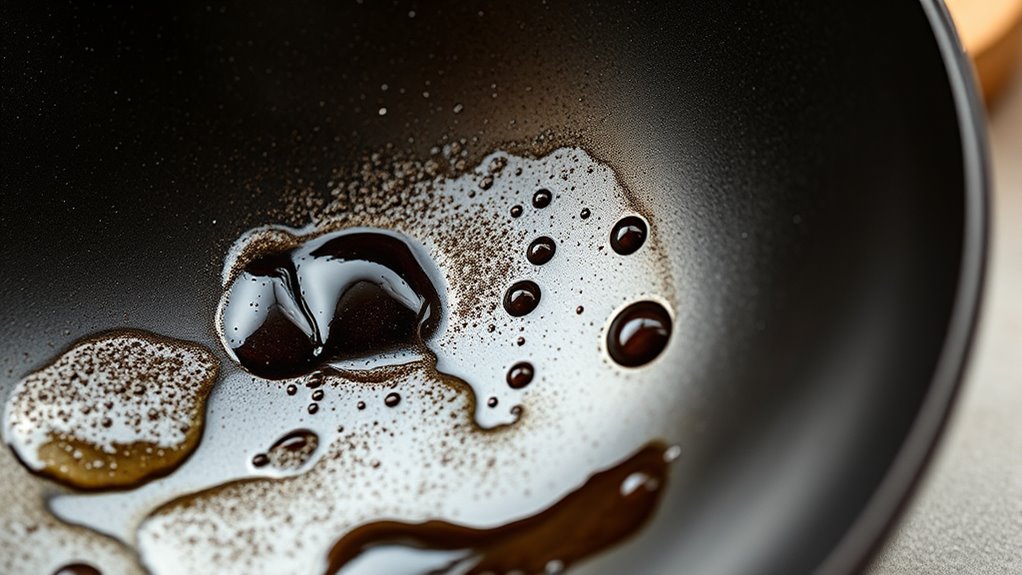
Choosing the wrong oil can ruin your seasoning process, so you need to take into account the smoke point first. Not all oils taste good with your wok, and some break down faster than others, affecting durability. Picking the right oil ensures your wok develops a strong, lasting non-stick surface and great flavor.
Smoke Point Matters
Using the wrong type of oil for seasoning your wok can lead to problems, especially if the oil’s smoke point is too low. When you heat oil past its smoke point, it produces smoke, damaging the seasoning layer and creating unpleasant flavors. Selecting oils with high smoke points ensures you can heat your wok thoroughly without breaking down the oil. Additionally, proper installation and venting of your stove help maintain a safe cooking environment and prevent dangerous fumes. Maintaining correct cooking techniques also plays a vital role in preserving your wok’s seasoning and ensuring optimal performance. Understanding the smoke point of different oils helps you choose the best option for seasoning and stir-frying. Recognizing the thermal stability of oils is crucial for maintaining their quality during high-heat cooking. Being aware of the oil’s chemical composition can further help you select oils that withstand high temperatures without degrading.
Flavor Compatibility Counts
Even if you select an oil with a high smoke point, it’s important to contemplate how its flavor will impact your wok’s seasoning and your dishes. Using oils with strong or incompatible flavors can alter the taste of your stir fry and compromise your wok’s seasoning over time. Consider these points:
- Avoid oils with overpowering tastes like sesame or extra virgin olive oil for seasoning.
- Use neutral oils such as vegetable or grapeseed to keep the wok’s natural flavor intact.
- Flavored oils can leave residues that interfere with your dish’s intended taste.
- Remember, the oil’s flavor influences not just the seasoning but every stir fry you cook.
- Additionally, choosing the appropriate oil can help maintain the integrity of your wok’s seasoning and prolong its usability.
- Selecting the right oil also involves understanding the smoke point, which is essential for proper stir-fry cooking and preserving the wok’s condition.
- Proper oil selection also helps prevent residue buildup that can affect future cooking sessions.
- Using the wrong type of oil can lead to spoiled seasoning, which impacts both flavor and the longevity of your wok.
- To optimize your stir-fry, consider how the oil’s composition interacts with your wok’s existing seasoning.
Oil Longevity Varies
The type of oil you select for seasoning greatly influences how long your wok’s coating will last. Some oils, like flaxseed or grapeseed, create a durable, hard layer that resists sticking and oxidation over time. Others, such as vegetable or sesame oil, may build up a coating initially but tend to break down faster, requiring more frequent re-seasoning. High smoke point oils generally form a more resilient layer, so choosing the right oil is vital for longevity. If you use the wrong oil—like one with a low smoke point or that oxidizes quickly—you’ll find your wok needing frequent re-seasoning. Picking the appropriate oil ensures your wok stays seasoned longer, saving you time and effort while maintaining a smooth, non-stick surface for your stir fries. Using the proper fat content and types of oil can also enhance the seasoning process and improve the durability of your wok’s coating. Additionally, understanding oil oxidation can help you select oils that resist breakdown and prolong the life of your seasoning layer. Being aware of the environmental impacts of oil production can also guide you toward more sustainable choices for your kitchen. Proper storage of your oils in cool, dark places can help prevent premature oxidation and spoilage, extending their usability.
Overlooking Proper Cleaning After Use
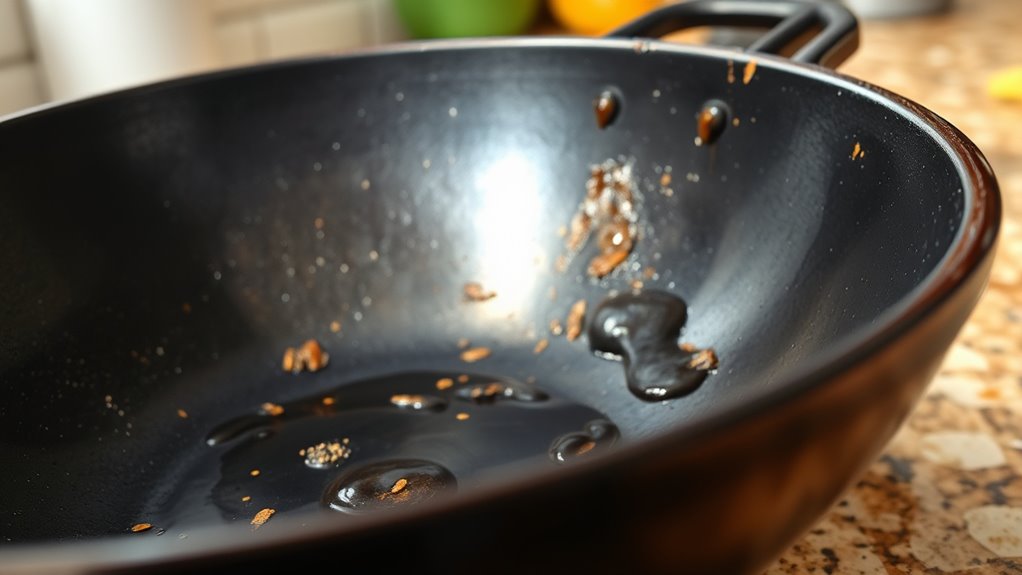
Neglecting to properly clean your wok after cooking can lead to seasoning mistakes that ruin its non-stick surface. When you skip cleaning, food residue and grease build up, preventing your wok from developing a smooth, even seasoning. To avoid this, keep in mind:
- Rinse immediately after cooking to remove loose debris.
- Use hot water and a soft brush—no soap, which can strip seasoning.
- Dry thoroughly to prevent rust formation.
- Apply a light oil coating before storing to maintain the seasoning layer.
- Regular maintenance also helps prevent rust formation and preserves your wok’s longevity.
- Incorporating proper cleaning techniques supports the development of a well-seasoned surface that enhances cooking performance.
- Understanding the importance of seasoning maintenance ensures your wok remains in optimal condition for future use.
- Proper cleaning techniques also promote the even distribution of seasoning across the wok’s surface, improving its non-stick qualities.
- Using the right cleaning methods is especially important for digital literacy programs, which encourage playful communication and proper care in tech devices.
Skipping these steps allows residue to harden and creates uneven seasoning patches. Over time, this compromises your wok’s non-stick qualities and affects stir fry results. Proper cleaning is essential to preserving a well-seasoned, high-performing wok.
Applying Too Much Oil During Seasoning
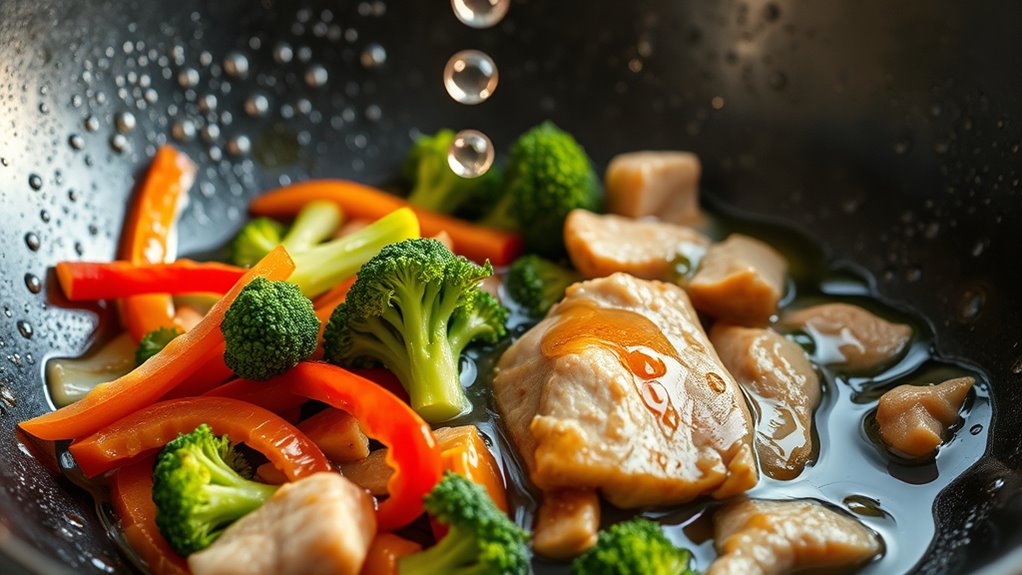
Applying too much oil during seasoning can undo your efforts by creating a sticky, uneven coating rather than a smooth, durable surface. When you over-apply oil, it clings to the wok’s surface, resulting in a tacky layer that attracts dirt and food particles. This not only hampers the non-stick qualities but can also cause uneven seasoning over time. To avoid this, use a small amount of oil and wipe away excess with a paper towel. Using proper Hyundai Tuning techniques can also enhance the overall performance and longevity of your cookware. Additionally, understanding the foundations of proper seasoning can help you achieve a better, more resilient coating for your wok. Remember that consistent maintenance practices are essential for maintaining a well-seasoned wok over the long term. Proper cleaning and careful re-seasoning are key to preventing buildup and residue, which can compromise your wok’s surface.
Not Heating the Wok Adequately During Seasoning
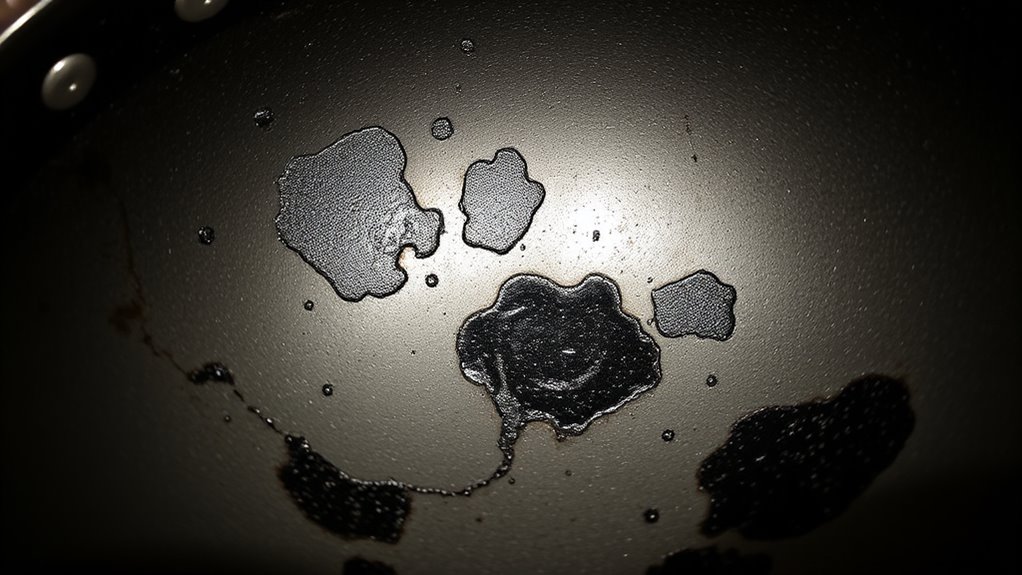
Properly heating your wok is essential for a successful seasoning process because it helps the oil polymerize and bond to the metal surface. If you don’t heat it enough, the oil won’t create a durable, non-stick layer. To guarantee proper heating:
Proper wok heating ensures effective seasoning and a durable, non-stick surface.
- Preheat your wok over high heat until it starts to smoke slightly.
- Use a few drops of water; if they evaporate instantly, the wok is hot enough.
- Avoid adding oil too early—wait until the wok reaches the right temperature.
- Continuously move the oil around to distribute heat evenly.
Skipping these steps results in uneven seasoning, weak bonds, and a sticky surface. Heating the wok correctly is the foundation for a durable, non-stick coating that improves with each use.
Failing to Maintain a Thin, Even Layer of Oil
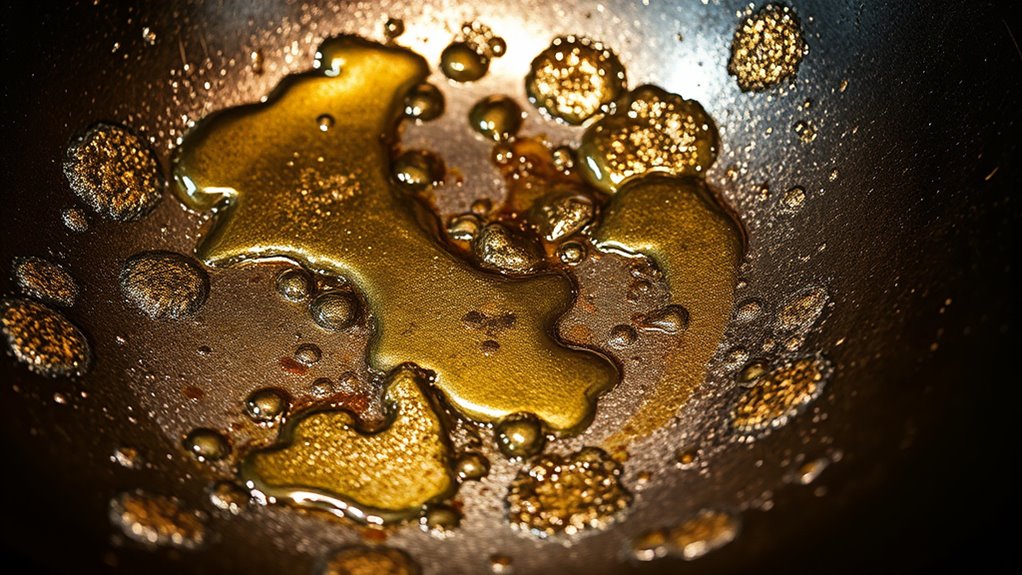
To achieve a durable, non-stick seasoning, you need to keep the oil layer thin and even across the wok’s surface. If the oil is too thick or uneven, it won’t bond properly, leading to a sticky or patchy surface. Use just enough oil to coat the wok lightly; too much creates a greasy layer that hampers seasoning. Spread the oil quickly and evenly with a cloth or paper towel before heating. Here’s how to think about oil application:
| Oil Amount | Effect |
|---|---|
| Thin Layer | Promotes even seasoning; prevents stickiness |
| Thick Layer | Causes uneven seasoning; creates a mess |
| Proper Spread | Ensures consistent, durable non-stick layer |
Maintaining control over the oil layer is vital for successful wok seasoning.
Ignoring Regular Re-Seasoning to Build Layering

When you skip regular re-seasoning, your wok can lose flavor depth and become dull. It also risks developing a sticky surface and weakens its non-stick layer. Without consistent maintenance, your wok won’t perform as well or last as long.
Loss of Flavor Depth
If you neglect regular re-seasoning, your wok can quickly lose its flavor complexity and depth. Over time, the seasoning layer becomes dull, and your stir-fries lack the rich nuances they once had. Without re-seasoning, you risk:
- Diminished smoky aroma that enhances dishes
- Fewer natural oils that deepen flavor
- Reduced non-stick quality, affecting ingredient taste
- Loss of the layered seasoning that builds complexity
This deterioration results in bland, flat stir-fries that miss the signature wok-charred taste. To preserve flavor depth, you need to maintain your wok’s seasoning regularly. Otherwise, your cooking will suffer, and the true potential of your stir-fry will fade away. Proper re-seasoning keeps the layers of flavor vibrant and your dishes delicious.
Increased Stickiness Risk
Neglecting to re-season your wok regularly can lead to increased stickiness, making it harder to cook ingredients smoothly. As the seasoning layer wears down, food is more likely to cling, especially with sticky sauces or sugary ingredients. Without proper maintenance, oil doesn’t form a smooth, non-stick surface; instead, it builds uneven patches prone to sticking. This stickiness can cause food to tear or break apart, ruining the texture of your stir fry. Over time, the wok’s surface becomes rougher, trapping bits of old seasoning and debris, which worsens sticking. To prevent this, you need to regularly re-season and build up a strong, layered coating. Proper maintenance ensures your wok remains smooth, non-stick, and ready for perfect stir-frys every time.
Weaker Non-Stick Layer
Failing to regularly re-season your wok prevents the formation of a strong, layered non-stick surface. Without consistent care, your wok’s coating becomes weaker, making food more likely to stick. To avoid this, focus on these key points:
- Neglecting Re-Seasoning – Skipping routine seasoning diminishes the protective layer.
- Using Harsh Abrasives – Scrubbing with steel wool strips away the already fragile non-stick coating.
- Cooking Acidic Foods Too Soon – Acidic ingredients can break down the seasoning if introduced prematurely.
- Ignoring Maintenance – Failing to oil and heat your wok after use hampers proper layer development.
Using Soap or Harsh Cleaners on a Well-Seasoned Wok
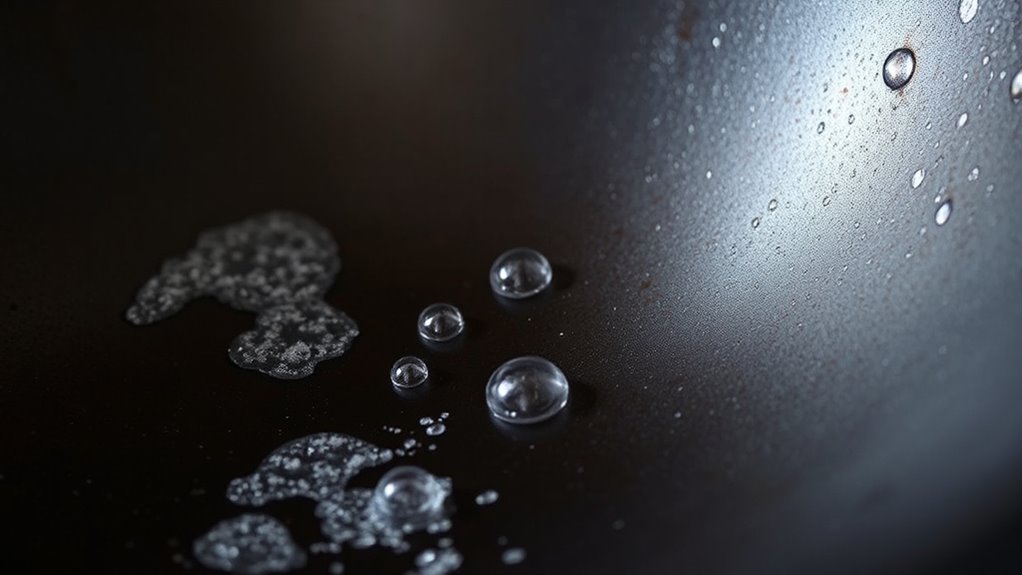
Many people believe that using soap or harsh cleaners is necessary to keep a wok clean, but doing so can actually damage its seasoned surface. Soap can strip away the natural oils that develop during seasoning, leading to a dull, sticky surface that’s hard to cook on. Harsh cleaners can remove or damage the seasoning layers, causing rust and deterioration over time. Instead, rely on hot water and a gentle scrub with a brush or sponge. If food sticks, simmer some water in the wok to loosen debris. Keep your wok dry afterward to prevent rust.
| Cleaning Method | Effect on Seasoning |
|---|---|
| Soap | Removes oils and seasoning |
| Hot water & brush | Preserves seasoning, cleans effectively |
| Harsh cleaners | Destroys seasoned surface |
Storing the Wok Improperly, Leading to Rust and Damage
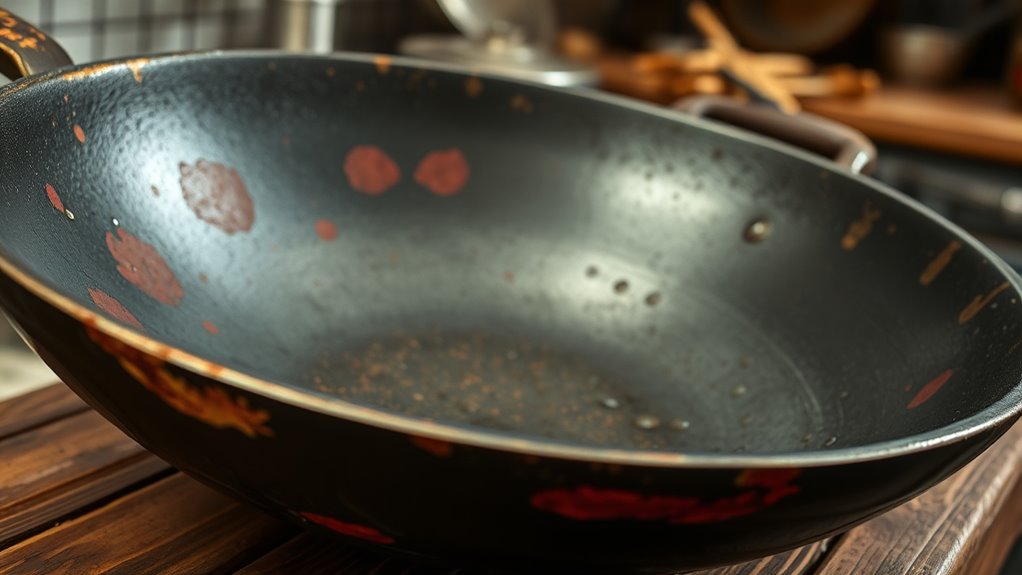
Storing your wok improperly can quickly lead to rust and damage, even if it’s well-seasoned. To protect your wok, avoid these common mistakes:
- Leaving it wet or damp after cleaning, which promotes rust.
- Storing it in a humid environment, like a closed cabinet without ventilation.
- Stacking heavy items on top, which can dent or warp the surface.
- Forgetting to apply a light coat of oil before storage, leaving it vulnerable to moisture.
Proper storage is simple but essential. Make sure your wok is completely dry, lightly oiled, and stored in a dry, well-ventilated place. This keeps it rust-free and preserves your seasoning, ready for your next stir fry.
Frequently Asked Questions
How Often Should I Re-Season My Wok for Optimal Performance?
You should re-season your wok whenever the surface starts to look dull or food begins to stick. Typically, this means reseasoning every few months or after about 10-15 uses. Regular maintenance keeps the surface non-stick and flavors well-developed. To keep it in top shape, clean it gently, dry thoroughly, and apply a thin layer of oil before storing. This routine guarantees your wok remains seasoned and ready for perfect stir fries.
Can I Use My Wok Immediately After Seasoning Without Cleaning?
You might think your wok is ready to go after seasoning, but rushing to cook immediately isn’t ideal. You should clean off any excess oil and residue first, or you risk sticking or off-flavors. Ironically, that quick skip can undo all your hard seasoning work. So, take a moment to wipe it clean after seasoning, then start cooking—your stir fry will thank you with better flavor and texture.
What Signs Indicate My Wok Needs Re-Seasoning or Maintenance?
You’ll know your wok needs re-seasoning when it starts sticking more food, develops dull or uneven surfaces, or shows visible rust spots. Also, if the seasoning layer becomes flaky or loses its non-stick quality, it’s time to refresh it. Regular maintenance keeps your wok performing well, so pay attention to these signs and re-season as needed to maintain a smooth, non-stick surface for perfect stir-fries.
Is It Necessary to Use Special Oils for Seasoning or Any Cooking Oil Works?
You don’t need special oils for seasoning your wok—any high-smoke point oil like vegetable, canola, or peanut oil works well. These oils create a durable, non-stick surface when heated properly. Avoid low-smoke point oils like olive or butter, which can burn easily and hinder the seasoning process. Use a thin layer, heat your wok until it smokes, and then let it cool to build up that perfect seasoned surface.
How Do I Prevent Rust if I Notice Discoloration or Spots?
Did you know that rust can develop on your wok within just a few days of neglect? To prevent this, you need to act quickly if you see discoloration or spots. After cleaning, dry your wok thoroughly, then apply a thin layer of oil to create a protective barrier. Regular seasoning and proper storage help keep rust at bay and make sure your wok stays in top shape.
Conclusion
If you skip these seasoning steps, you might find your stir fry falling flat—literally. It’s funny how a small mistake, like ignoring proper cleaning or over-oiling, can quietly ruin your wok’s non-stick magic. Sometimes, it’s the simple act of maintaining your wok’s layers that keeps your dishes flavorful and flawless. After all, in the kitchen, as in life, the smallest care can make the biggest difference—don’t let neglect be your undoing.
